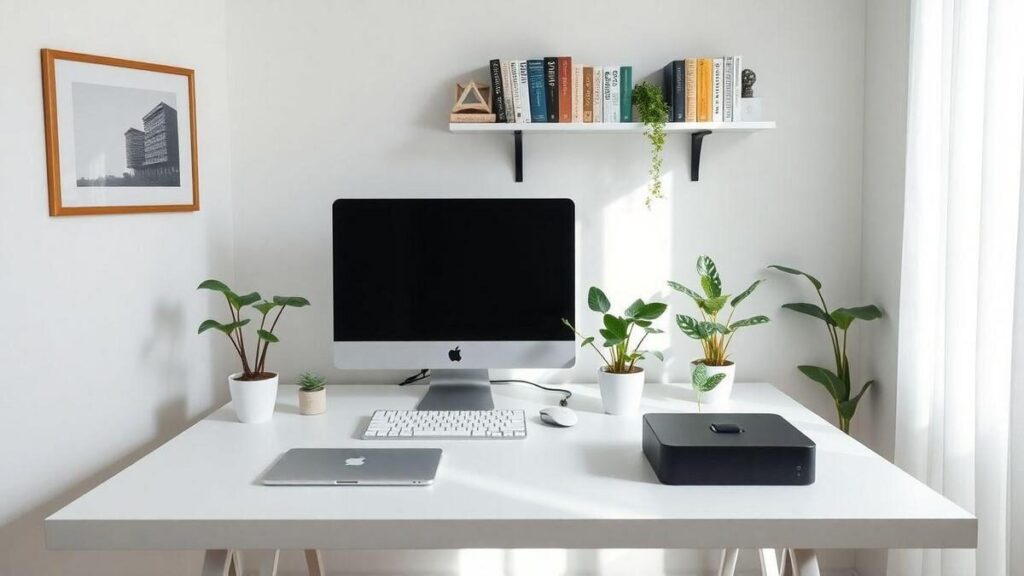How to Organize Your Workspace and Be Productive

How you can make your workspace more productive is essential for anyone looking to improve their performance. In this article, I'll show you how to exploit the importance of organization your environment and offer you practical tips that make your day-to-day life easier. From productivity even how to create a space inspiringEach step can transform your routine. Get ready to discover how small habits and simple adjustments can make a big difference to your homework!
How to Organize Your Workspace to Be More Productive: Step One

When we think about being more productiveWe often think of time management techniques or to-do lists. But have you ever stopped to think that the environment in which we work can have an impact on our lives? Imagine yourself in a messy office, with papers scattered everywhere and an uncomfortable, noisy chair. Now compare that to a clean, organized and welcoming space. Which one inspires you more to work? The first step to increasing your productivity can simply be organizing your workspace.
The Importance of Organizing the Workspace
Clutter can be one of the main causes of distraction. A messy workspace not only makes organization difficult, it can also hinder your productivity. Organization brings mental clarity and makes it easier to focus on tasks. When everything is in its proper place, you can concentrate better and, consequently, produce more in less time.
In addition, an organized environment conveys a professional image, whether in a physical office or a home office. This can positively influence the way your colleagues and clients perceive you. Therefore, investing time in organizing your space is a fundamental step for anyone who wants to be more productive.
Organization Tips for a Productive Workplace

Now that we understand the importance of organization of the workspaceHere are some suggestions for transforming your space:
- Discard what doesn't fit: Start with a general clean-up. Throw away old papers, broken objects and anything else that is of no use. This will free up space and clear your mind.
- Create work zonesSeparate your space into specific areas. For example, one area for the computer, another for writing materials and a third for meetings. This helps to keep everything in the right place.
- Use organizers: Boxes, folders and document holders are great allies. They help keep everything tidy and accessible. Try labeling them to make them even easier to find.
- Keep the table clean: Try to leave only the essentials on your desk. A clean space is more inviting and helps to avoid distractions.
- Decorate sparinglyA personal touch is always great, but avoid overdoing it. Plants, pictures or photos can bring life to the room, but remember that the focus should be on the productivity and not aesthetic.
Productivity techniques that really work
In addition to an organized space, there are techniques that can help increase your efficiency. productivity. Let's take a look at some of them:
- PomodoroThis technique consists of working out for 25 minutes and then taking a 5-minute break. After four cycles, you take a longer break. This helps keep you focused and avoids distractions with your cell phone.
- GTD Method (Getting Things Done)This approach involves capturing all your tasks and organizing them into lists. This way, you can focus on what's most important at any given time.
- Prioritize your tasksUse the Eisenhower Matrix to classify your activities into urgent and important. This helps direct your energy towards what really matters.
- Set daily goalsWhen you start your day, write a list of the tasks you want to complete. This creates a sense of purpose and direction.
- Eliminate distractionsIdentify what distracts you the most and look for solutions. It could be silencing cell phone notifications or using headphones to drown out external noise.
Office Tidying: How to Start and Maintain Order

Keeping order in the office may seem like a difficult task, but with a few strategies, it becomes much easier. Here are some tips to get you started and keep your space organized:
- Establish a cleaning routine: Set aside time each week to organize your space. It may only take 15 minutes, but it's enough to keep the mess under control.
- Organize at the end of the dayBefore you finish your work, take a few minutes to tidy up your desk. Put everything in its place and get ready for the next day.
- Use the 2-minute ruleIf a task can be done in two minutes, do it immediately. This prevents small tasks from piling up and creating clutter.
- Review regularly: Every month, review what you have in your space. Discard what you no longer need and reorganize what is out of place.
- Create a filing system: Use physical or digital folders to organize documents. This makes it easier to locate important information and keeps the space clean.
Ergonomics at Work: Comfort that Increases Productivity
Did you know that the comfort of your workspace can directly affect your productivity? Ergonomics is key to ensuring that you are comfortable while working. Here are some tips for improving the ergonomics of your environment:
- Choose a suitable chair: Invest in a chair that offers lumbar support and is adjustable. This helps prevent back pain and increases comfort.
- Adjust the height of the tableThe height of your desk should allow your arms to be at a 90-degree angle while you type. If necessary, use stands to raise your computer.
- Position the screen correctly: The computer screen should be at eye level, about an arm's length away. This prevents excessive strain on the eyes and neck.
- Keep your feet on the ground: When you sit down, your feet should rest on the floor or on a support. This helps maintain circulation and prevents discomfort.
- Take breaks to stretchGet up and stretch every hour. This helps to relieve muscle tension and maintain energy.
Time Management: The Secret to Working Better and Faster

Managing your time effectively is essential in order to increase your productivity. productivity. Here are some tips to help you:
- Plan your day: Start each day with a plan. Take a few minutes to define your priorities and goals.
- Use time management toolsApplications such as Trello, Todoist or Google Calendar can be great allies in organizing your tasks.
- Avoid multitasking: Focusing on one task at a time is more efficient than trying to do several things at once. This helps ensure that you do quality work.
- Set realistic deadlines: Give yourself deadlines that are challenging but also possible to meet. This helps to keep you motivated.
- Review your progressAt the end of the day or week, review what you have achieved. This helps you identify areas for improvement and adjust your planning.
Small Habits that Transform Your Daily Routine
Sometimes it's the little habits that make the biggest difference. Let's take a look at some practices that can transform your daily routine:
- Start the day with a morning routineTake time in the morning to prepare yourself mentally. This can include meditation, exercise or even a healthy breakfast.
- Make gratitude listsWrite down three things you are grateful for every day. This helps to keep a positive outlook and motivation high.
- Disconnect from social media: During working hours, avoid accessing social networks. This helps you stay focused and productivity.
- Prioritize self-careTake time to look after yourself, whether it's exercising, reading a book or practicing a hobby. This helps to recharge your batteries.
- Set clear boundaries: Set times to start and finish work. This prevents overload and helps maintain a healthy work-life balance.
Conclusion
In short, organizing your workspace is a fundamental step towards increasing your productivity and well-being. By adopting small changes and habits, such as disposing of unnecessary items and the creation of specific zones, you can turn your environment into a place of your own. inspiring and efficient. Remember, a clean and comfortable space not only improves your concentrationbut also reflects its professionalism.



